Search engine optimization (SEO) goes hand-in-hand with reputation management. You can combine the two to directly influence how your brand appears in search results and what others are saying about it. In this guide, I'll show you how to do so in 8 simple steps.
What you will learn
- What SEO reputation management is and why it matters.
- The connection between SEO and online reputation.
- Key strategies to manage brand perception in search results.
What is SEO reputation management?
SEO reputation management is an ongoing process of tracking and shaping how your business appears in traditional search engine and AI generated results. It's a multi-step practice that can achieve different goals, such as:
- Promoting positive content
- Improving brand sentiment
- Suppressing negative results
- Building and maintaining credibility
Many of these goals can be achieved through traditional online reputation management. The "SEO" component addresses the unique impact of a negative reputation on organic web presence, such as poor reviews, outdated information and weak credibility.
Why is SEO reputation management important?
SEO reputation management is important because it shapes your brand's first impression when potential customers search for you online.
Most people don't go beyond page #1 in Google (91% don't even scroll to the bottom), which is typically reserved for reputable websites and credible sources of information.
Today, a brand’s reputation is affected by what shows up on Google, AI answer engines, review platforms, and traditional PR and social media. These elements directly reflect your site's reputation and public perception, so successful reputation management ensures you don't overlook them.
An effective SEO reputation management strategy ensures that positive, accurate, and brand-controlled content dominates search results, while outdated, misleading, or negative information is pushed down.
It ensures long-term brand protection.
Your brand's growth may not always be smooth sailing, and strategic reputation management helps maintain visibility and shape users' opinions during crises or negative press.
8 steps to effective SEO reputation management
While the specifics of your SEO reputation management strategy will differ according to your brand's current online reputation, here are the general steps to follow:
1. Audit your site's reputation
Each SEO reputation management tactic must serve a specific purpose, such as:
- Building a positive reputation (if you're new to the industry)
- Improving brand trust and credibility
- Fixing broken trust or an otherwise poor reputation
To outline the key goals, you must first look at your current standing. The most effective approach here is to do the same thing as your audience—Google your brand.
You can either search for the brand alone or add specific keywords like "reviews" or "customer service." Either way, browse the search results on the first page or two to see what comes up.
You'll probably see a mix of owned pages, social profiles, and third-party pages. For example, when I Google TravelFreak, the first page shows that mix:
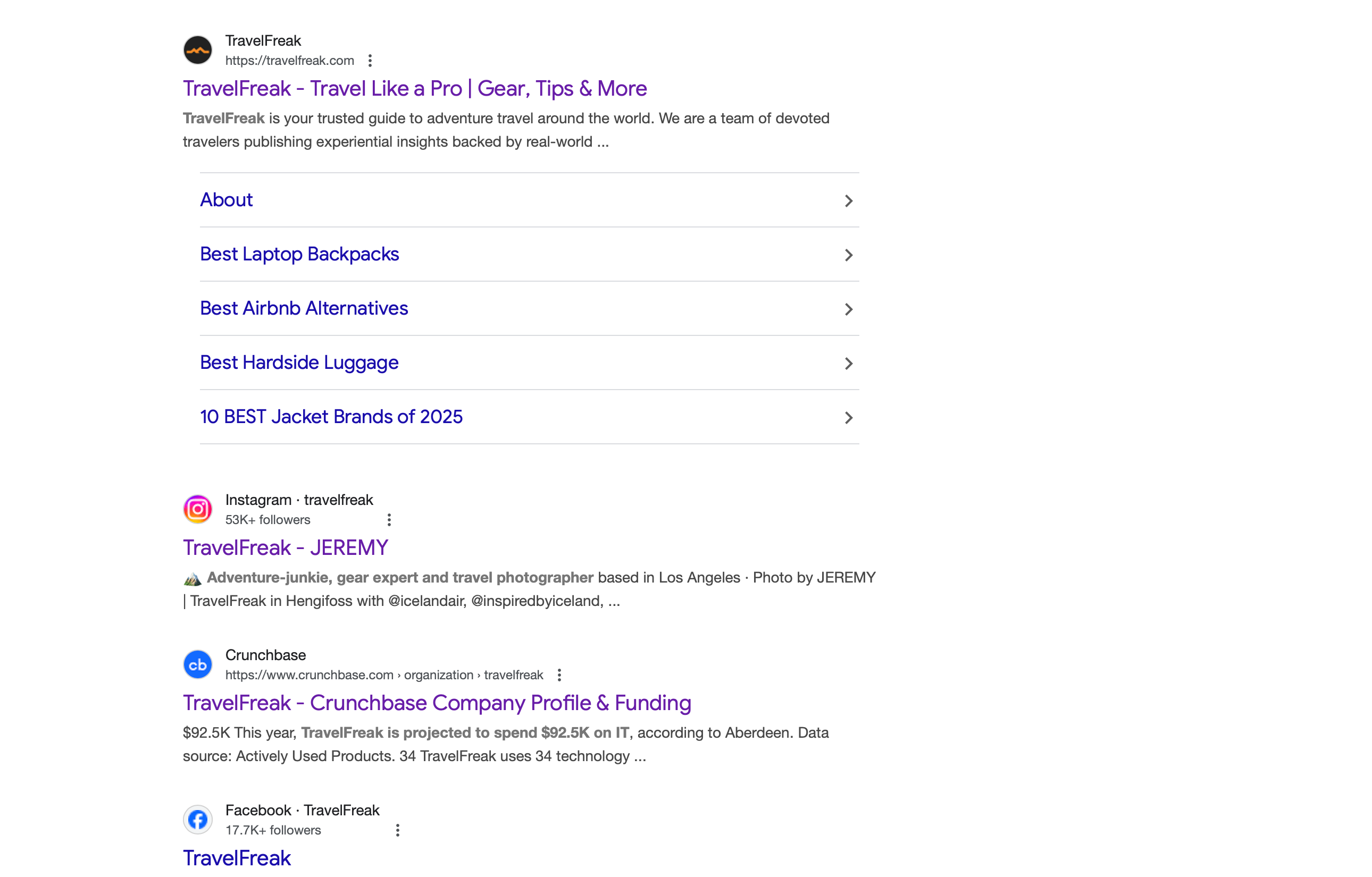
You should also track your brand mentions in AI search results.
Head to Surfer AI tracker, and look at your Visibility score – an overall metric showing your brand's appearance and ranking in AI platforms like ChatGPT and Perplexity.
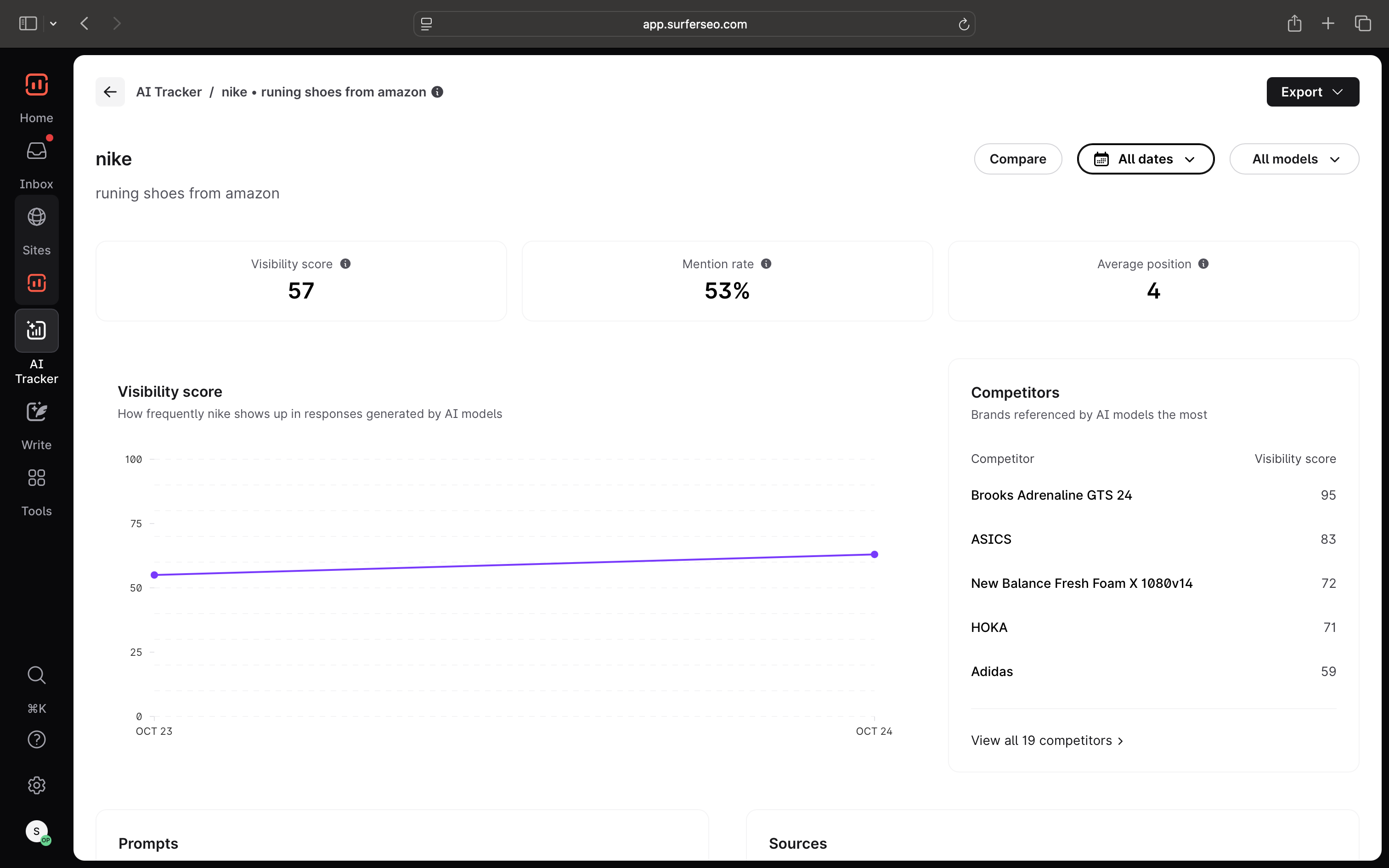
Enter prompts that are relevant to your business and see how your brand is being spoken about.
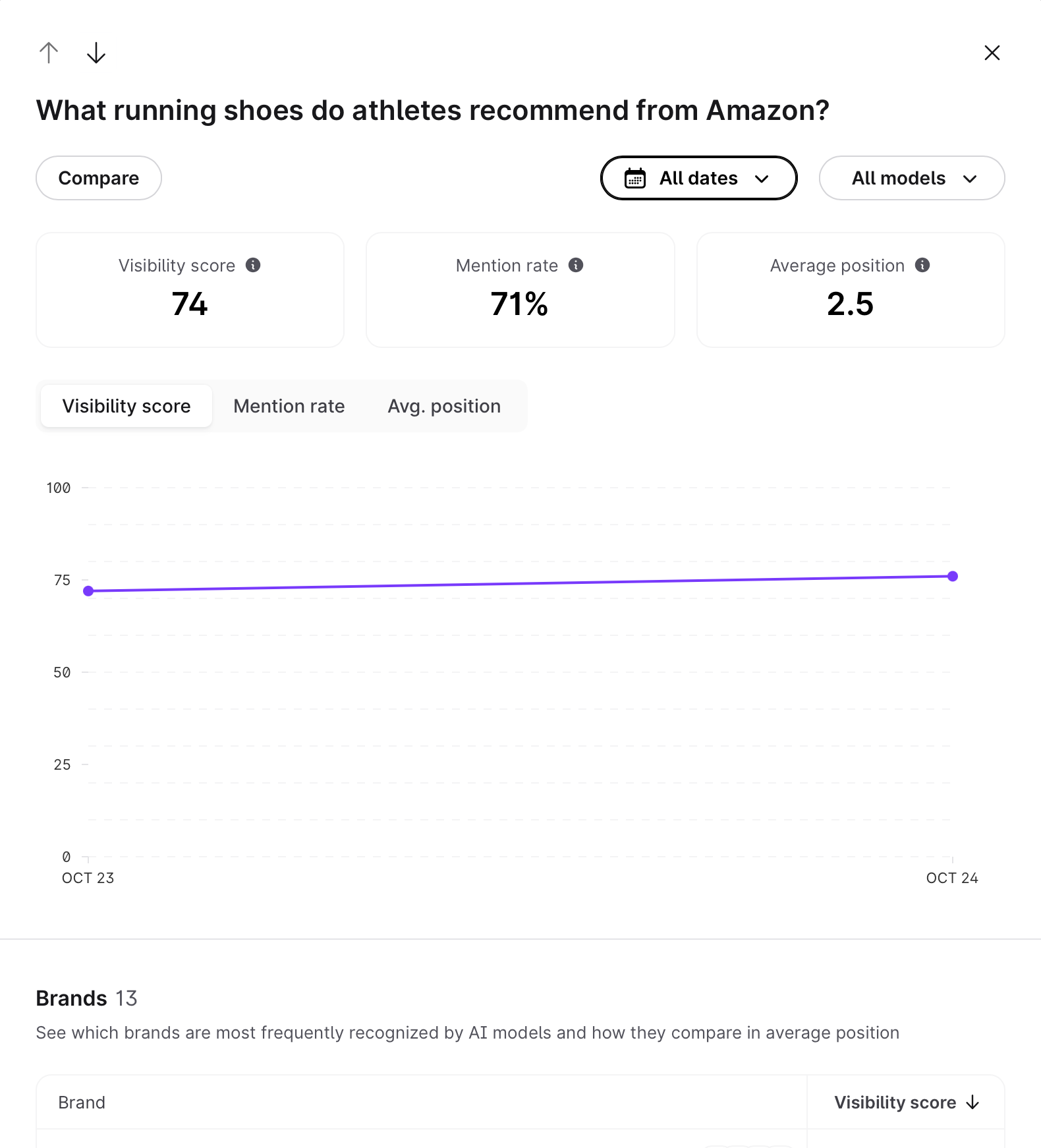
When you look at the results, ask yourself:
- Are there any pages with a negative sentiment (e.g., poor reviews)?
- Does owned content establish rapport with the audience?
- Is there any outdated information that should be refreshed?
Answers to these questions will determine the next steps.
I'll cover some of these actions throughout the guide, but you get the idea—see where your brand stands when you perform a Google search, and see what you can do about the best-ranking results to grow, improve, or fix your reputation.
2. Optimize your key pages
No matter what your reputation audit uncovers, you need to make sure your site's key pages convey authority and credibility. Specifically, focus on these pages:
- Home page
- About
- Clients/Customer Testimonials/Case Studies
Your home page is meant to capture the reader's attention and connect them to your brand immediately, so pay special attention to the messages it's sending. The copy must establish credibility and highlight the value of your offer to position it as authoritative. At the same time, it needs to be optimized for high-value keywords relevant to your niche.
Take SurveyMonkey as an example. The home page's meta title positions the platform as the most popular survey platform, instantly creating a sense of trust and authority.
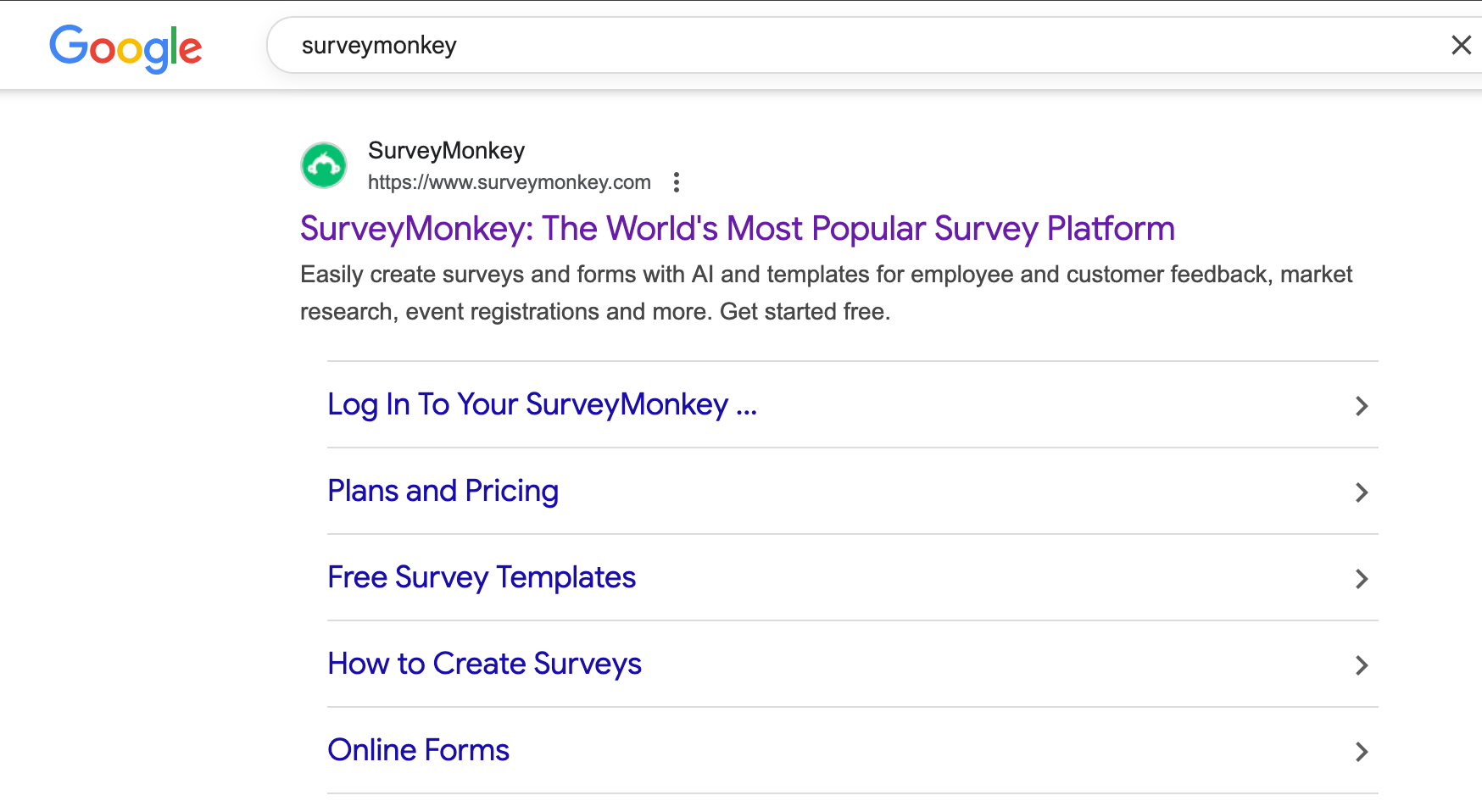
When you open the page, you're met with short copy that further assures the user that SurveyMonkey is a reliable solution. More importantly, reputable brands are included as clients above the fold, which ensures authority by association.
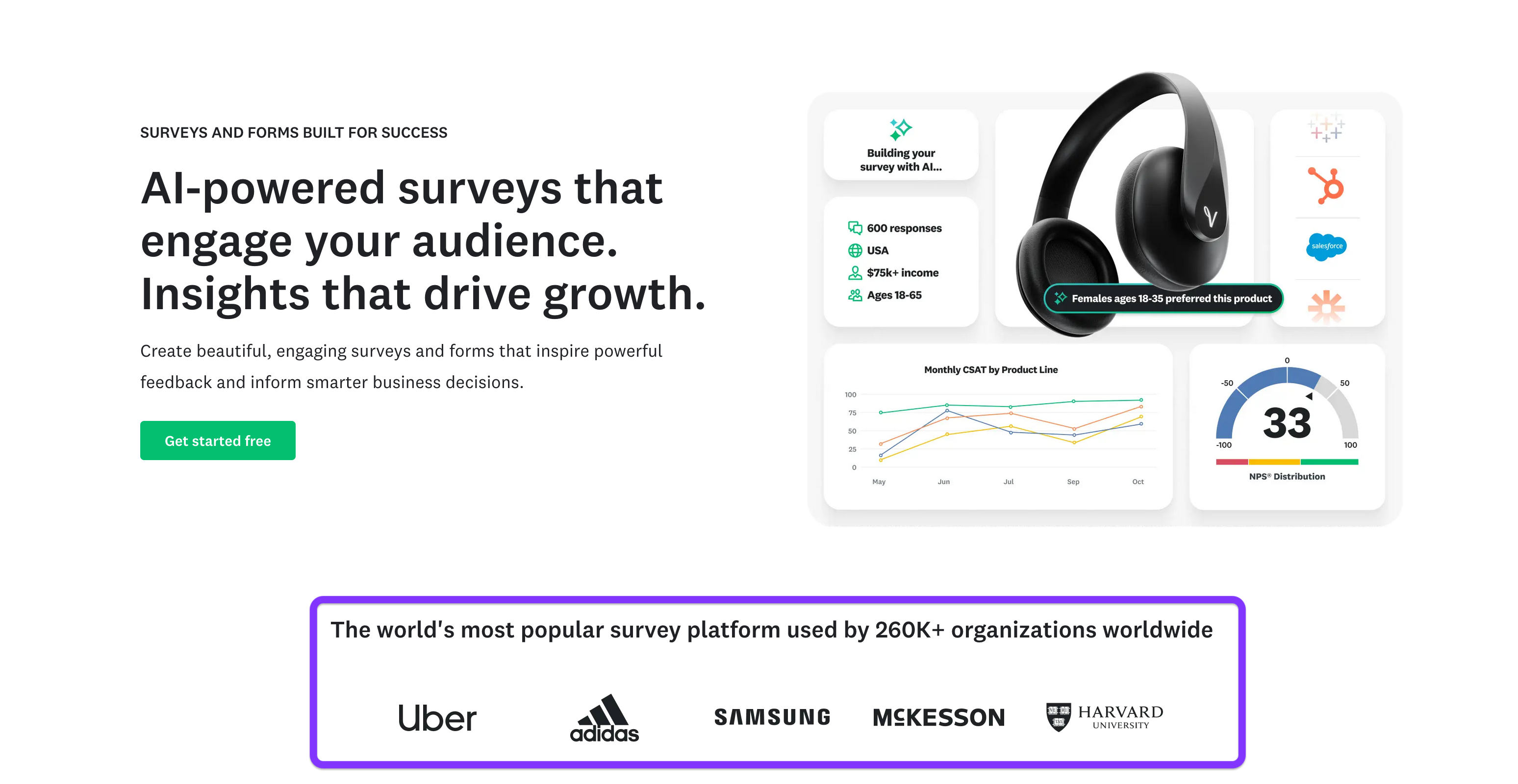
While the home page is important for leaving a good first impression, the About page is where you'll communicate most of your brand's credibility. Make sure it includes:
- Team bios with experience, education, and expertise details
- Notable achievements
- Brand story, mission, and history
Besides these essentials, highlight any trust signals relevant to your brand and industry. For example, PwC highlights their work with Fortune 500 companies, team growth, and gross revenue.
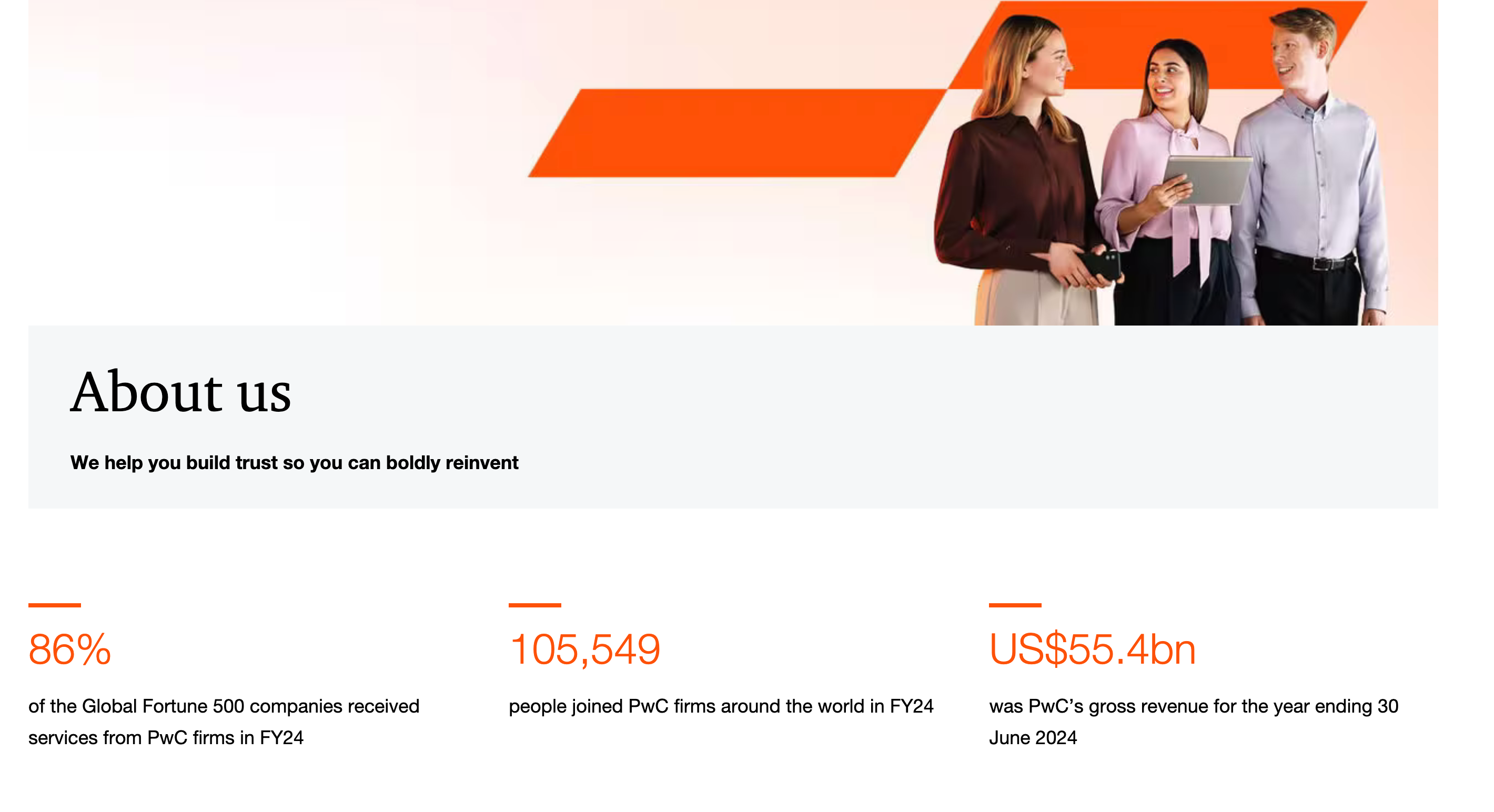
Think about the aspects of your business that matter most to your audience, and include them in the About page to position your brand as reputable.
Finally, each website should have a dedicated section for reviews or customer testimonials. Customers trust their peers more than brands, so you need to show them you can get real-life results.
For example, Slack has a rich Customer Stories page with plenty of results-driven case studies and testimonials.
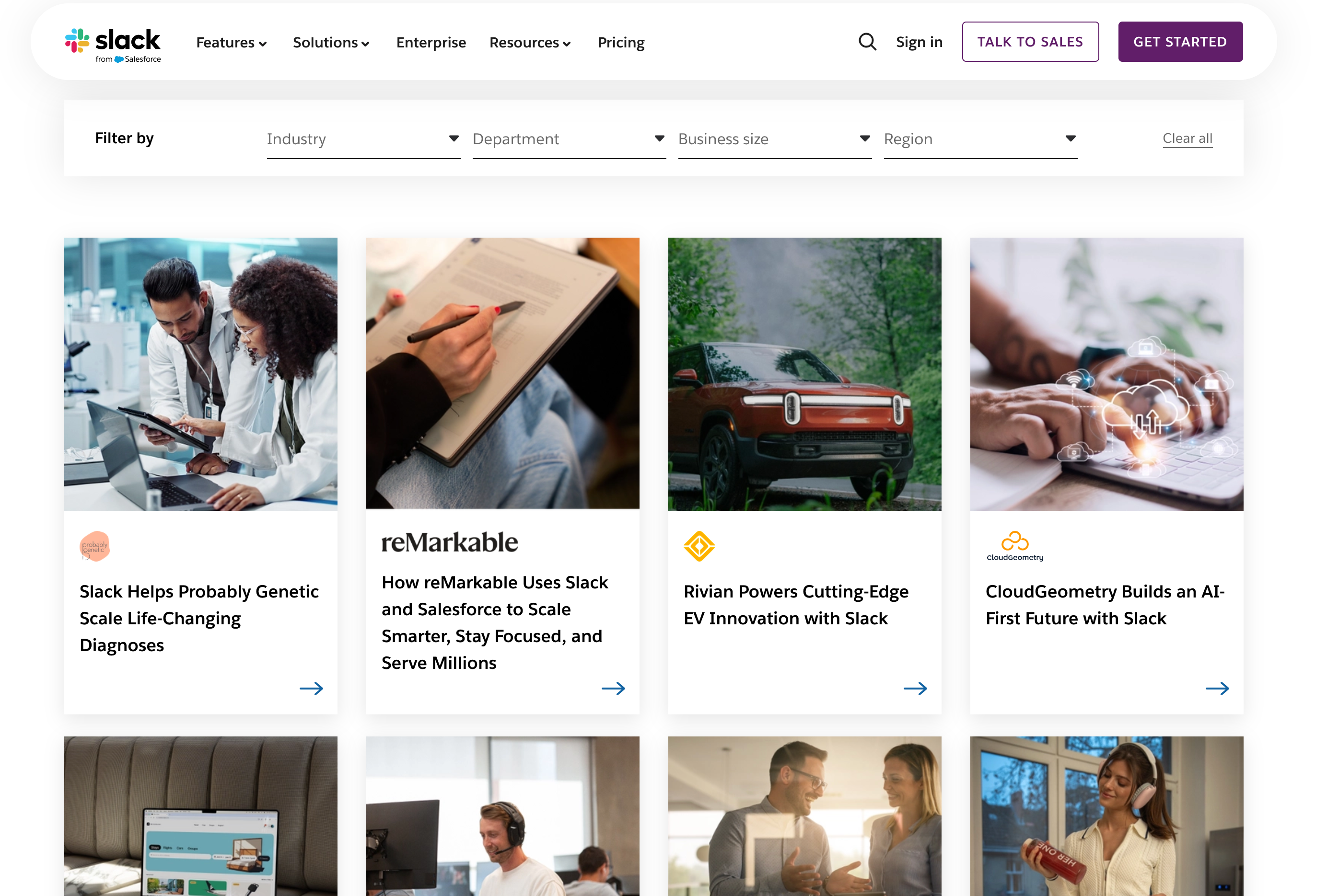
Creating such a page may be challenging if your brand is new, but be patient and don't hesitate to ask customers to share their stories. Testimonials can do more for your reputation than most outward brand messaging, so prioritize them to build and maintain your reputation.
Besides forming trust with your audience, they send positive signals to Google that help rank your site higher.
3. Optimize your reviews and listings ecosystem
If you have a brick-and-mortar business, your reputation is largely determined by your standing on platforms like:
- Google Maps (and Google Business Profile)
- Apple Maps
- Bing Places
- General directories (e.g., Yelp and Tripadvisor)
- Industry-specific directories
You need to have a firm grasp of all these directories and take several important steps to manage your reputation.
First, make sure your NAP (Name, Address, Phone) citations are consistent across platforms. Any discrepancies may cause confusion and suspicion in search engines, and their failure to verify your information will likely lead to a lower rank.
Next, take a close look at your Google Business Profile listing. It will appear in the business section of search engines as a part of the local Map Pack, which highlights the three top-ranking listings related to the given keyword (besides the one sponsored listing):
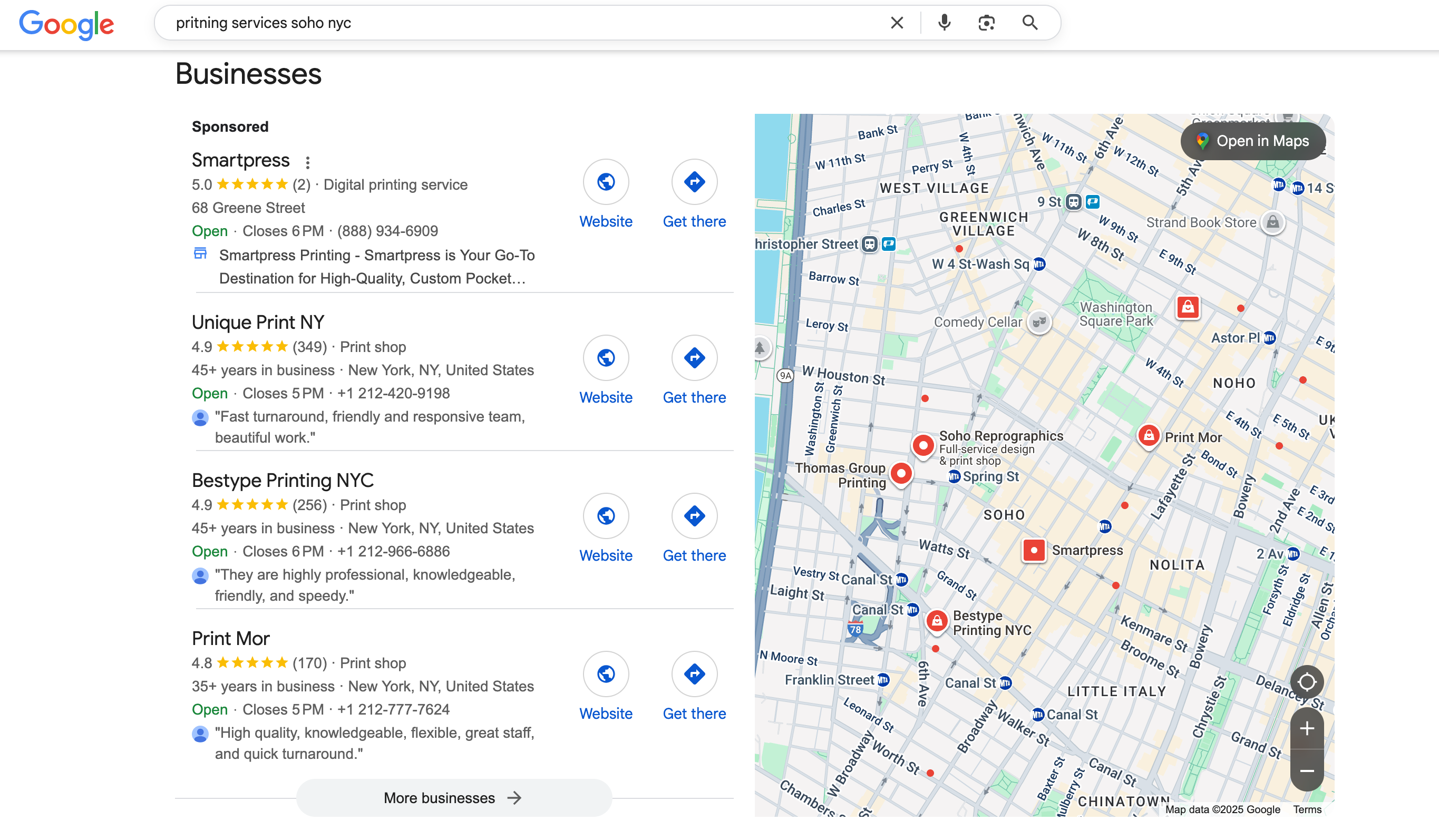
To appear in the Map Pack, you need to follow a few important local SEO best practices, most notably:
- Add accurate business information (NAP, working hours, services, etc.)
- Write a detailed, SEO-friendly description
- Add compelling images and videos to the page
Most importantly, you must manage your GBP reviews effectively. Besides encouraging positive reviews, you should respond to all the reviews you get—especially the negative ones. Doing so helps reshape the narrative and show that you care about your customers' experiences, which can greatly benefit your reputation.
If you need an example of a well-written response to negative feedback, this one checks all the right boxes:
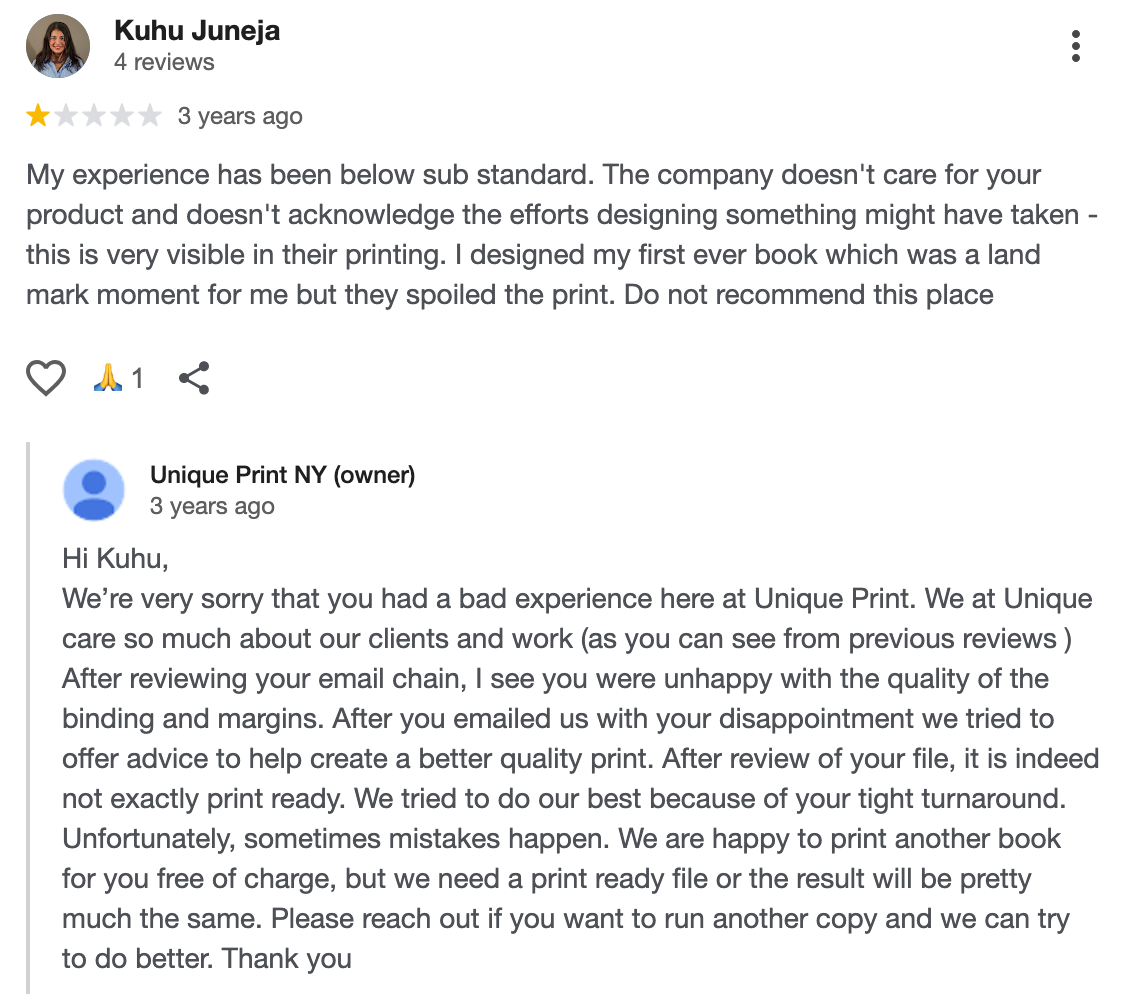
Finally, go beyond GBP to implement the right reputation management practices across local platforms and directories.
Look into the conversations surrounding your brand in directories and review sites, and engage with your audience to clean any reputation stains.
4. Blend content creation with PR
SEO heavily relies on content, which helps you passively build a solid reputation by consistently providing valuable information. That said, there's a specific content type that lets you own the narrative surrounding your brand—PR content.
By this, I don't mean press releases and media appearances. I'm talking about the content that targets reputation-focused keywords, such as:
- "[brand] + reviews"
- "[brand] + alternatives"
- "[brand] vs. [competitor]"
- "is [brand] legit"
Targeting these keywords blends SEO and reputation management by accomplishing several goals, most notably:
- Helping you rank for both your own and a competitor's branded keywords
- Controlling the narrative by ranking content above review sites and third-party sources
- Letting you highlight your USPs and benefits over competitors'
Salesforce is a perfect example of a well-executed PR content campaign. If you Google "salesforce reviews", you'll see the company's page at the top of SERPs.

Search for alternatives, and you'll see the same.

Even if you compare Salesforce to specific competitors, you'll see their comparison on page #1:
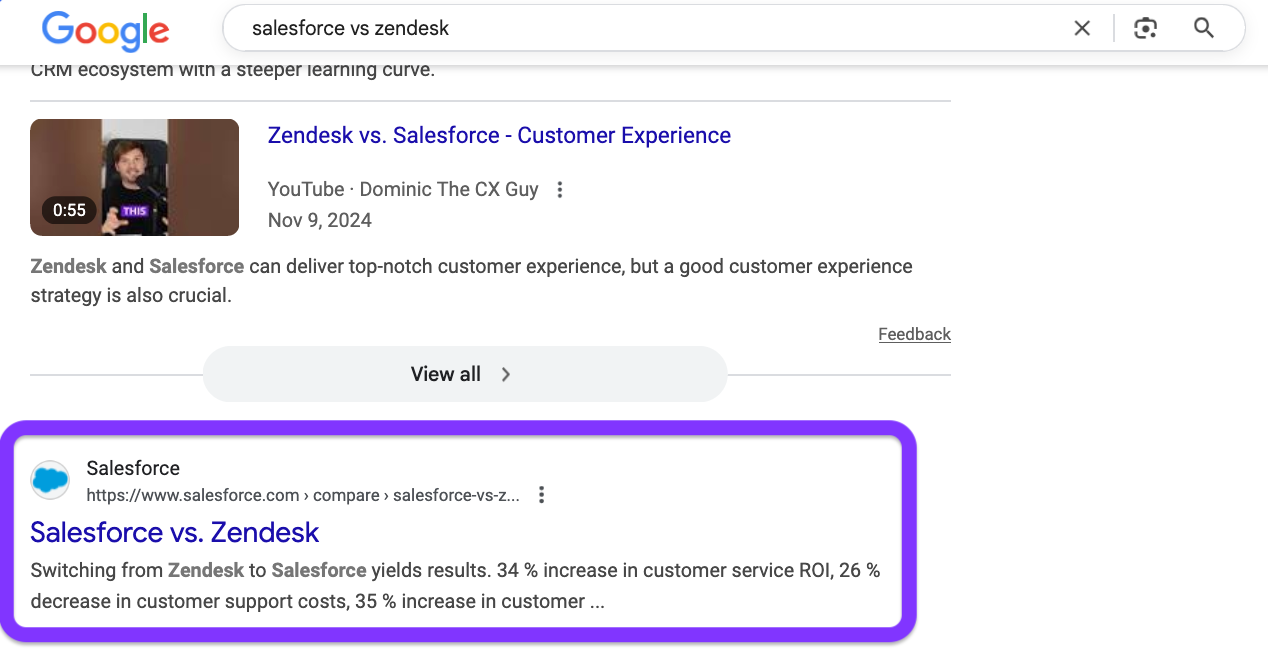
This way, Salesforce dominates the search landscape for branded keywords and has direct control over the audience's opinions. By creating robust PR content, you can achieve the same, as long as you:
- Don't badmouth the competition
- Stay honest about your solution's pros and cons
- Gather genuine customer reviews for your site's Testimonials page
5. Create shareable assets
One of the most effective ways to boost your reputation is to be considered a credible source worth citing. You can do this regardless of your niche by publishing shareable content like:
- First-party research
- Industry reports
- Expertise/experience-based pieces
For example, Redfin has a comprehensive data center that is regularly updated with valuable real estate insights.
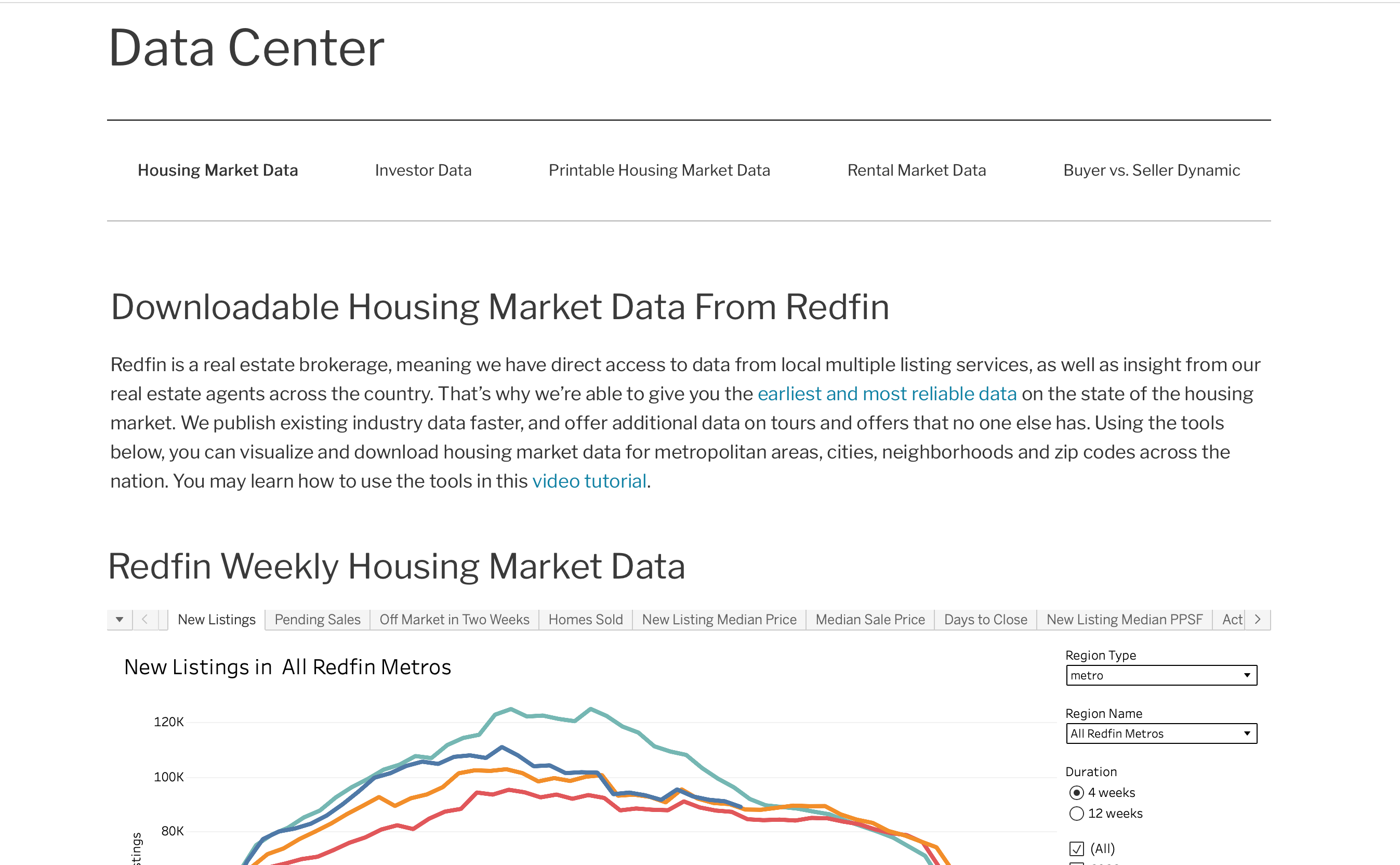
Creating such a knowledge hub positions you as an authority in your niche and can significantly boost your brand visibility as others cite your content. It also directly impacts your search engine rankings by helping you build a strong backlink profile.
In Redfin's example, we can see that the site has over 11,000 backlinks from more than 1,500 websites, which does wonders for the brand's reputation and helps both Google and users see it as an authoritative source.
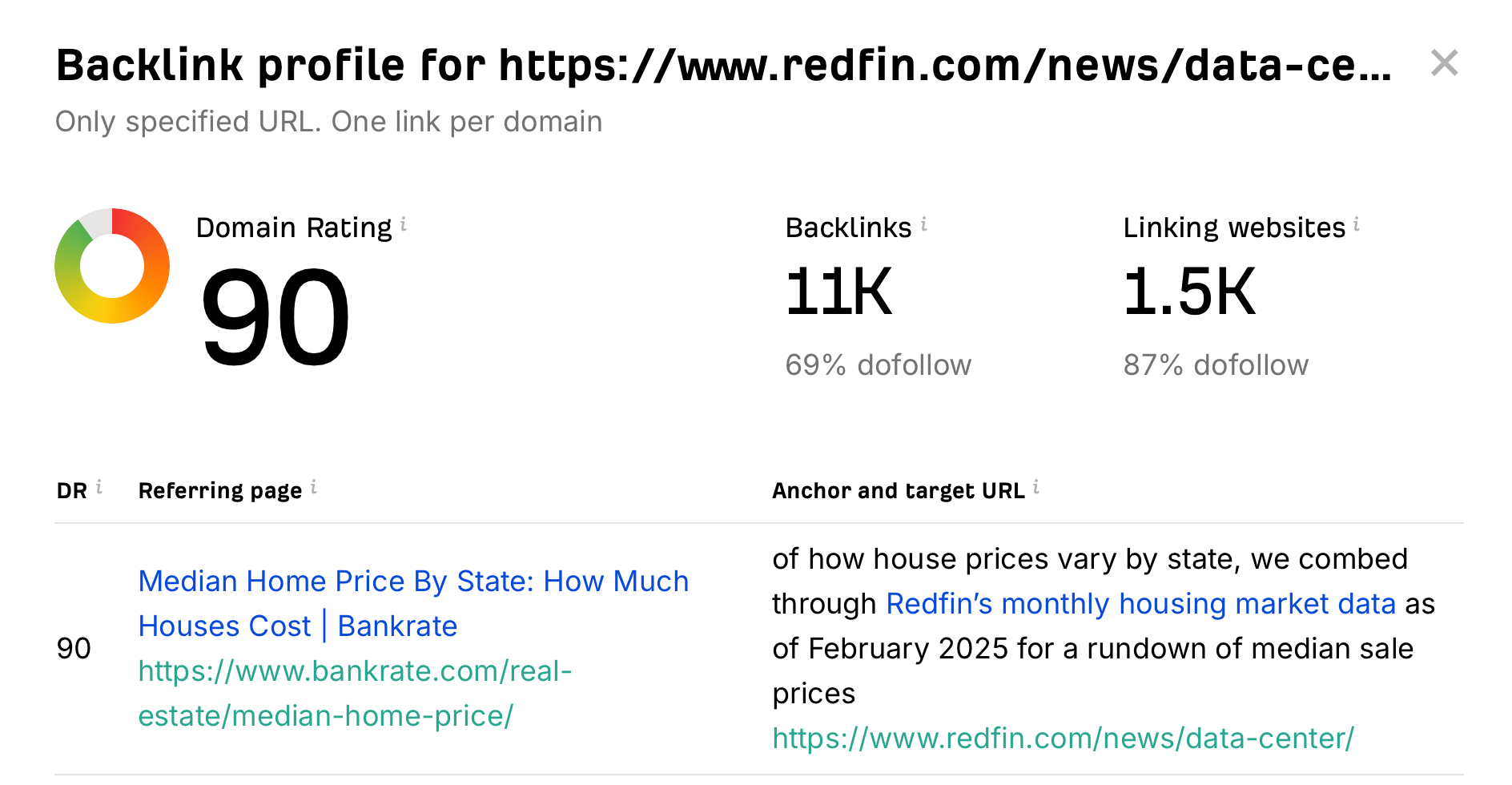
6. Manage your reputation on social media
When someone Googles your brand, they won't only see your site but also your social profiles. This is where many of the conversations surrounding your brand happen, so having a firm grasp of them and engaging your audience is crucial to staying on top of your reputation.
Social media lets you manage your reputation both proactively and reactively. By regularly asking your audience for their opinions through polls or Q&As, you can get plenty of feedback that will tell you exactly how they feel about you and whether there's anything you can improve on.
Wendy’s is a good example of real-time social media PR, turning its X/Twitter presence into a masterclass in brand voice management.

The fast-food chain has a reputation for witty, playful, and sometimes savage responses to competitors and customers, a tone that resonates with younger audiences and humanizes the brand.
As for the reactive approach, there are plenty of ways to handle any negative feedback effectively, such as:
- Setting up alerts for issues: You can set up real-time notifications for specific keywords (e.g., "[brand] + bug" or "[brand] + refund" to spot issues quickly before negative word of mouth spreads.
- Troubleshooting via DM: If someone raises an issue, you can enter a chat with them to fix it. You can then publicly summarize the solution in a reply.
- Turning wins into UGC: Besides sharing success stories, you can share the ways you've resolved your customers' issues to show your audience you care about their experience.
While social media activity may not directly impact traditional SERP results, it's a useful signal for brand visibility among AI generated results.
Effective customer engagement leads to more brand mentions with positive sentiment, which can make Google favor your brand in search results.
7. Develop a crisis and suppression plan
While negative reviews can be helpful in finding areas of improvement, excessive or intentionally malicious negative press can put a significant dent in your reputation. In some cases, responding or fixing a problem may not be possible, in which case you may need to push negative content down in SERPs.
However, this is a difficult strategy that is beyond your control and could take months.
Peloton is a classic example of poor crisis management.
The company found itself embroiled in a major reputation crisis when its treadmill was linked to multiple injuries.
The company’s delayed acknowledgement and recall compounded negative press, legal penalties and widespread erosion of consumer trust.

The best way to do this is by creating net-new content that directly addresses negative claims or accusations. For instance, if someone accuses your product of being a scam, you can target the related keywords to occupy more slots in search results.
While doing so, make sure not to create duplicate content by targeting the exact same keyword with different pieces. Instead, use variations (e.g., "is [brand] a scam," "is [brand] legit," or issue-specific ones like "does [brand] offer refunds").
For example, Amazon knows it has a problem with fake reviews, and addresses it with a page that shows up when you search for this topic.

Besides suppressing negative posts, think about whether they can be removed altogether. For example, you can ask Google to remove a specific page if:
- It's unlafwul
- It violates Google's policies
- It's otherwise harmful to your rights
One thing you should never do is try to artificially fix negative press by buying or fabricating positive reviews. This is bound to backfire and harm your reputation even more, so stick to legitimate practices.
8. Monitor your brand's online reputation
Both SEO and reputation management are ongoing practices, so you should continuously track your brand's search performance and sentiment.
Make sure to go beyond Google search results when monitoring your brand—track LLM platforms, social media sites, forums, and other sources that might mention your brand.
Some of the key metrics to track include:
- Page-one owned assets
- Visibility and mention scores
- Average star rating by platform
- Review volume
- Sentiment trend
You can set up Google alerts for branded keywords to monitor brand conversations around the web and stay on the lookout for any reputation issues.
Surfer's AI Tracker can help monitor and optimize your brand's online reputation in AI generated results. You'll be able to track competitors, prompts and pages that are relevant for your business.
Here for example, you can see all the pages that cite Surfer as a top content optimization tool.
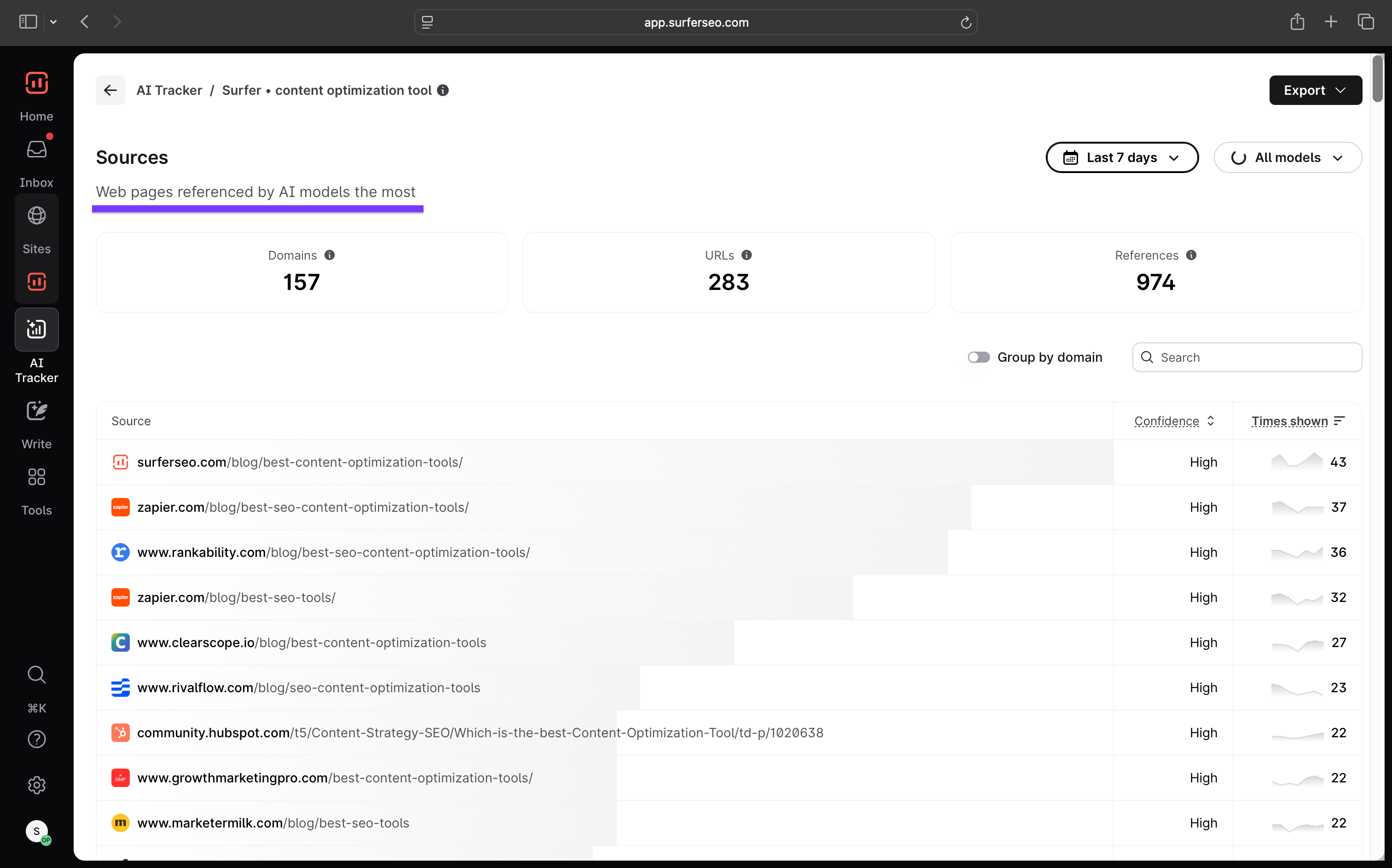
This is especially important given the rise of AI search, which draws on many sources beyond your site to answer users' questions.
By tracking online conversations across the board, you can stay on top of the narrative at all times.
Key takeaways
- SEO reputation management is the ongoing process of shaping how your brand appears in SERPs by promoting positive assets, improving sentiment, and suppressing negatives. The goal is to ensure that credibility and organic performance reinforce each other.
- First impressions happen on page one of SERPs. Strong reputation signals (E-E-A-T, helpful content, solid UX, credible sources) lift rankings, while positive reviews, mentions, and press compound off-page authority and protect you during crises.
- Google your brand to audit your current reputation. Inventory page-one results, flag negatives or outdated info, and map each finding to a specific fix.
- Make your Home, About, and Testimonials/Case Studies pages radiate authority. Publish clear value props, evidence-rich bios and milestones, and social proof. Align copy to high-value keywords, and surface trust signals above the fold.
- Ensure NAP consistency across GBP/Maps, Apple Maps, Bing, and niche directories. Optimize your GBP listing, add media, and respond to every review (especially negative ones) to influence local pack visibility and public sentiment.
- Publish content that targets competitive and PR-focused keywords like “[brand] reviews” or “[brand] alternatives“ to own the narrative on branded queries. Be honest about your pros/cons, cite proof of any claims, and try to rank above third-party sites without disparaging competitors.
- Publish first-party research, data hubs, and experience-based guides that others will want to cite. Such content earns natural links and mentions, strengthening authority and pushing positive pages up (and negatives down).
- Use social media to engage with your audience in real-time proactively and reactively. Turn resolved issues into UGC and wins to highlight your focus on positive customer experiences.
- If you notice malicious or overly negative content, see if it's eligible for removal. If not, try suppressing it by creating content that targets the related queries and variations.
- Track page-one owned assets, branded CTR, star ratings, review volume, and sentiment trends. Set alerts and use listening tools across search, socials, and forums to spot and resolve any reputation issues quickly.






